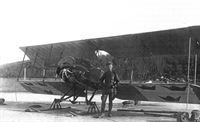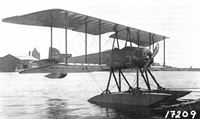J.Forsgren Swedish Military Aircraft 1911-1926 (A Centennial Perspective on Great War Airplanes 68)
Thulin E
Following the outbreak of war, the Swedish parliament decreed to purchase four reconnaissance biplanes. Following receipt of the order, AETA commenced the design of a two-seat biplane. Although the resulting Thulin E was very similar to the Gotha LD 5 (Kavallerie Flugzeug), the Thulin E could with some stretch of the imagination be considered as the first indigenous Thulin design. Incidentally,Thulin made the rather preposterous claim that the Thulin E was similar in appearance to the Albatros B.II!
All four airplanes had been completed in the spring of 1916. After being test flown, the first two Thulin E’s were delivered to AFK, becoming serial numbers 26 and 30. As per contemporary standards, the pilot sat in the rear seat, and the observer (encumbered by struts and wings to block his view) in the front seat. The third production Thulin E was fitted with floats, after which it was handed over to AFK for continued trials as serial number 32. The final Thulin E became serial number 36.
One Thulin E, serial number 32, was destroyed in a crash on January 26,1917.
All four Thulin E’s were despatched to the north of Sweden for the 2.Flygavdelningen (2.Flight Section), being used to patrol the border with Finland. During summertime, the airplanes were fitted with twin floats, and skis during the winters. According to Gosta von Porat, the quartet of Thulin E’s formed the ’’Aerial Armada of northern Sweden.”
The last three remaining Thulin E’s were struck off charge in December 1920, not having been flown for a considerable time.
Gosta von Porat considered the Thulin E as being a substandard airplane: Tt was not beautiful, the upper wing sat very high and was entirely straight, without V-shape. The rear fuselage was very short and the tail section lacked a stabilizer, it was replaced with a huge compensating elevator. (...) It was also a beast to fly. As it turned out, the elevator was over compensated, being overly sensitive, the rudder possibly normal, and the ailerons largely without effect. It was very unstable, staggering in despair during the slightest uneveness in the air. And for years, I struggled with that rascal. Without enthusiasm, it must be admitted.”
Thulin E Technical Data and Performance Characteristics
Engine: 1 x 90 h.p. Thulin A rotary engine
Length: 6,45 m
Wingspan: 11,40 m
Height: 3,00 m
Wing area: 32,00 m2
Take-off weight: 785 kg
Thulin L
By early 1916, plans to expand AFK strength resulted in 12 reconnaissance airplanes being ordered from AETA (four Thulin L’s), Nordiska Aviatik AB (four NAB 9’s, ie Albatros B.II) and Sodertelge Verkstader (four SW 12’s, ie Albatros B.II), respectively. It is interesting to note that Enoch Thulin was strongly opposed to the Albatros B.II, claiming it to be both too heavy and unsuited for AFK requirements.
A development of the Thulin E, the Thulin L featured a number of improvements, including a redesigned tail plane. Another external difference from the earlier Thulin E was the sloped upper section of engine cowling. The pilot’s seat was moved to the front, with the observer occupying the rear seat. According to the contract, signed on July 4, 1916, the Thulin L was to have a maximum speed of 115 km/h (landplane) and 105 km/h (floatplane), a take-off run of 60 metres and landing run of 70 metres (both landplane). Also, four men would be able to assemble a Thulin L in 45 minutes, and disassemble it in 15 minutes. In order to further improve the working conditions for the observer, large cut-outs were made in the lower wings to ease vertical photography.
The four Thulin L’s were delivered between November 1916 and March 1917, becoming serial numbers 38, 40, 42 and 44, respectively. By April 1917, the Thulin L’s were serving with the 2.Flygavdelningen (2.Flight Section). The following month, the unit deployed to Abisko in the far north of Sweden, close to the Norwegian border. When flown on skis and with full military load, the fuel load (and, consequently, endurance) had to be reduced.
On January 5, 1918, one Thulin L (44), crashed off Umea after running out of fuel during a long distance flight.
Already from the beginning, it had been intended to fit a twin float landing gear to the Thulin L. Special ’’Hydro-wings” with increased wing area to 42 m2 were built, with flight tests being conducted at Lake Roxen outside Linkoping. When fitted with floats, the Thulin L had a much reduced performance, particularly with regards to the rate of climb. Nevertheless, six sets of twin floats and 24 ’’Hydro-wings” were ordered. In the event, these floats and wings were not issued for service. On May 14,1918, it was proposed to sell off these items.
In October 1917, a fifth Thulin L (serial number 48) was obtained in part-exchange for a Bleriot XI. This particular Thulin L was fitted with a double set of controls.
When the war ended in November 1918, the 2.Flygavdelningen (2.Flight Section) disbanded, with the remaining Thulin L’s all being returned to Malmen. They were used for basic flight training as well as artillery spotting before being struck off charge in December 1920. However, the airplanes had by then been grounded for several months.
Incidentally, the fuselage of a Thulin L was later used in the construction of the FVM Triplanet.
Thulin L Technical Data and Performance Characteristics
Engine: 1 x 90 h.p. Thulin A rotary engine
Length: 7,50 m
Wingspan: 11,60 m
Height: 3,52 m
Wing area: 36,50 m2
Take-off weight: 965 kg







